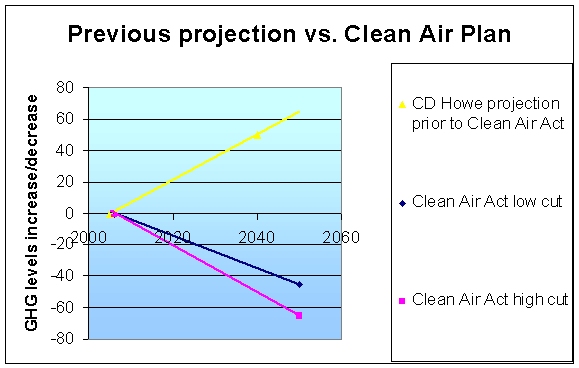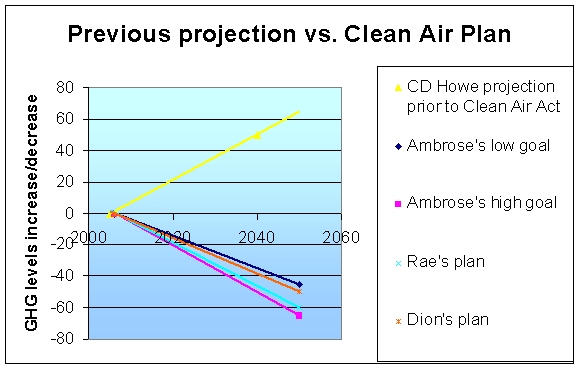Everyone seems to be hopping mad about Minister Ambrose’s Clean Air Act that was released in the foyer outside the House yesterday.
I’ve done some reading and found a 2005 CD Howe report titled “Burning Our Money to Warm the Planet“.
I’ve reproduced the executive summary below:
For 15 years Canadian governments have layered one greenhouse gas (GHG) policy over another — the 1990 Green Plan, the 1995 National Action Program on Climate Change, Action Plan 2000 on Climate Change, the 2002 Climate Change Plan for Canada and Project Green in 2005. The names changed, but the policy approach did not: it consisted primarily of offering information and subsidies to encourage voluntary reductions in emissions. Without substantial restrictions or charges for emitting GHGs, Canadian emissions have grown by 25 percent since 1990, outstripping the emission targets and commitments set by the government.
As a result of investments in energy supply, infrastructure, buildings and energy-using devices, we continue on the GHG-intensive path, and the cost of diverting from it in future keeps rising. This is to be expected in a market economy where there are many benefits to businesses and individuals from burning fossil fuels, and these actions overwhelm the effect of voluntary efforts to reduce GHGs. This explains why the evidence from international experience with energy efficiency and climate policy suggests that emission charges or regulations are necessary if the GHG intensity of the economy is to be reduced over the next several decades.
In spite of the mounting evidence that Canada’s policies were not working, the government’s last major policy initiative, Project Green, represented an intensification of the information and subsidy approach.
A forecast based on a continuation of this approach suggests that Canadian emissions would increase by 50 percent within 35 years. Even the anticipated regulation of industrial emissions in its present form would be swamped by growth in key sectors, such as oil sands production and fossil-fuel-based electricity generation. If this policy approach continues, we will spend at least $80 billion over the next 35 years — but without reducing GHG emissions.
Many Canadians believe we have been taking action on climate change when we have actually been doing little. In fact, it could be argued that without a substantial shift in policy, we will be burning our money to warm the planet.
Five GHG plans over the past 15 years?! I suppose that Minister Ambrose’s makes the sixth.
Fact: Canada’s GHG levels up by 25% since 1990.
Forecast: Canada’s GHG levels up 50% by 2040 (based on the plans prior to Ambrose’s plan), and Canada $80 Billion out of pocket.
Last night on CTV News, David Akin reported that the chief complaints were that GHG cuts wouldn’t happen until 2020, and that the lowering of GHG levels by 45-65% by 2050 is too far away.
2050 being 44 years away seems to be the main point of ridicule of the Conservative Green Plan.
Let’s review, since 1990, GHGs have gone up 25% and resetting our reference point to the year 2005, they were projected to go up by 50% by 2040 by CD Howe.
Ambrose’s plan is to cut GHGs by 45-65% by 2050. Perhaps best represented by a graph:

The Yellow line represent CD Howe’s projection of how we’d proceed under the previous GHG plans. The blue line represents the 45% low end goal under the Clean Air Act and the purple line represents the 65% high end goal under the Ambrose’s legislation. Of course, it would be useful to ask CD Howe to make new projections (if it could) under the legislation. Although, it should be said that their projections were made from observation of the real situation instead of legislative goals which may or may not be met.
Let’s add some more data to the graph and integrate Stephane Dion and Bob Rae’s plan for cutting GHG emissions.
First, let’s quote Rae.
Commit to coming as close as possible to Canada’s Kyoto objectives for 2012, and establish firm targets for subsequent periods, including matching European Union targets of 15-30% below current levels by 2020. Commit Canada to the long term target recommeded by the National Rountable on the Environment of a 60% reduction in emissions by 2050.
The common knowledge is that if we were to meet Kyoto targets in the very near future, it would be from buying Hot Air credits from other nations. It would cost us money and Canada wouldn’t be helping. One key criticism of the Conservative plan is that it doesn’t set intermediate targets. This is valid criticism. The long term goal of Bob Rae, however, is pretty much the same as that of Rona Ambrose.
And now Stephane Dion (Mr. Gavel Banger at the world climate conference in Montreal):
An extensive study by the National Roundtable on the Environment and the Economy has concluded that Canada should set an emissions reduction target of 60% below 1990 levels by the year 2050. This target is consistent with the international scientific consensus that a global 50% reduction will be required by 2050. I would adopt the 2050 target as proposed by the National Roundtable on the Environment and the Economy.
Dion proposes a 50% reduction in GHGs by 2050.
Let’s put Rae and Dion’s long term goals on the graph.

I hope this provides more context for the debate.
Note: GHG levels in 2020 are unknown relative to today. Projections are based on data available in 2005/2006 and 2050. Simplified graphs assume a linear relationship (actual results over the next 50 years will vary). Graphs are only provided as a rough illustration to show the difference between plans and CD Howe’s projection under previous plans.